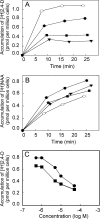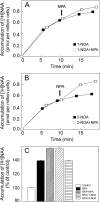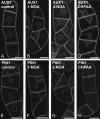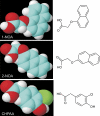Auxin influx inhibitors 1-NOA, 2-NOA, and CHPAA interfere with membrane dynamics in tobacco cells
- PMID: 20595238
- PMCID: PMC2921198
- DOI: 10.1093/jxb/erq172
Auxin influx inhibitors 1-NOA, 2-NOA, and CHPAA interfere with membrane dynamics in tobacco cells
Abstract
The phytohormone auxin is transported through the plant body either via vascular pathways or from cell to cell by specialized polar transport machinery. This machinery consists of a balanced system of passive diffusion combined with the activities of auxin influx and efflux carriers. Synthetic auxins that differ in the mechanisms of their transport across the plasma membrane together with polar auxin transport inhibitors have been used in many studies on particular auxin carriers and their role in plant development. However, the exact mechanism of action of auxin efflux and influx inhibitors has not been fully elucidated. In this report, the mechanism of action of the auxin influx inhibitors (1-naphthoxyacetic acid (1-NOA), 2-naphthoxyacetic acid (2-NOA), and 3-chloro-4-hydroxyphenylacetic acid (CHPAA)) is examined by direct measurements of auxin accumulation, cellular phenotypic analysis, as well as by localization studies of Arabidopsis thaliana L. auxin carriers heterologously expressed in Nicotiana tabacum L., cv. Bright Yellow cell suspensions. The mode of action of 1-NOA, 2-NOA, and CHPAA has been shown to be linked with the dynamics of the plasma membrane. The most potent inhibitor, 1-NOA, blocked the activities of both auxin influx and efflux carriers, whereas 2-NOA and CHPAA at the same concentration preferentially inhibited auxin influx. The results suggest that these, previously unknown, activities of putative auxin influx inhibitors regulate overall auxin transport across the plasma membrane depending on the dynamics of particular membrane vesicles.
Figures






Similar articles
-
Novel auxin transport inhibitors phenocopy the auxin influx carrier mutation aux1.Plant J. 2001 Feb;25(4):399-406. doi: 10.1046/j.1365-313x.2001.00970.x. Plant J. 2001. PMID: 11260496
-
Inhibitors of the carrier-mediated influx of auxin in suspension-cultured tobacco cells.Planta. 2000 Mar;210(4):580-8. doi: 10.1007/s004250050047. Planta. 2000. PMID: 10787051
-
Determination of auxin transport parameters on the cellular level.Methods Mol Biol. 2014;1056:241-53. doi: 10.1007/978-1-62703-592-7_22. Methods Mol Biol. 2014. PMID: 24306878
-
Auxin transport: providing a sense of direction during plant development.Biochem Soc Trans. 2000;28(4):481-5. Biochem Soc Trans. 2000. PMID: 10961944 Review.
-
Going the distance with auxin: unravelling the molecular basis of auxin transport.Philos Trans R Soc Lond B Biol Sci. 1998 Sep 29;353(1374):1511-5. doi: 10.1098/rstb.1998.0306. Philos Trans R Soc Lond B Biol Sci. 1998. PMID: 9800211 Free PMC article. Review.
Cited by
-
Current insights into hormonal regulation of microspore embryogenesis.Front Plant Sci. 2015 Jun 10;6:424. doi: 10.3389/fpls.2015.00424. eCollection 2015. Front Plant Sci. 2015. PMID: 26113852 Free PMC article. Review.
-
RopGEF1 Plays a Critical Role in Polar Auxin Transport in Early Development.Plant Physiol. 2017 Sep;175(1):157-171. doi: 10.1104/pp.17.00697. Epub 2017 Jul 11. Plant Physiol. 2017. PMID: 28698357 Free PMC article.
-
Inhibitors of plant hormone transport.Protoplasma. 2016 Nov;253(6):1391-1404. doi: 10.1007/s00709-015-0897-z. Epub 2015 Oct 22. Protoplasma. 2016. PMID: 26494150 Review.
-
Polar auxin transport: an early invention.J Exp Bot. 2012 Jun;63(11):4213-8. doi: 10.1093/jxb/ers106. Epub 2012 Apr 2. J Exp Bot. 2012. PMID: 22473986 Free PMC article.
-
Lateral root initiation and formation within the parental root meristem of Cucurbita pepo: is auxin a key player?Ann Bot. 2018 Nov 3;122(5):873-888. doi: 10.1093/aob/mcy052. Ann Bot. 2018. PMID: 29684107 Free PMC article.
References
-
- Benková E, Michniewicz M, Sauer M, Teichmann T, Seifertová D, Jürgens G, Friml J. Local, efflux-dependent auxin gradients as a common module for plant organ formation. Cell. 2003;115:591–602. - PubMed
-
- Bennett MJ, Marchant A, Green HG, May ST, Ward SP, Millner PA, Walker AR, Schulz B, Feldmann KA. Arabidopsis AUX1 gene: a permease-like regulator of root gravitropism. Science. 1996;273:948–950. - PubMed
-
- Blilou I, Xu J, Wildwater M, Willemsen V, Paponov I, Friml J, Heidstra R, Aida M, Palme K, Scheres B. The PIN auxin efflux facilitator network controls growth and patterning in Arabidopsis roots. Nature. 2005;433:39–44. - PubMed

